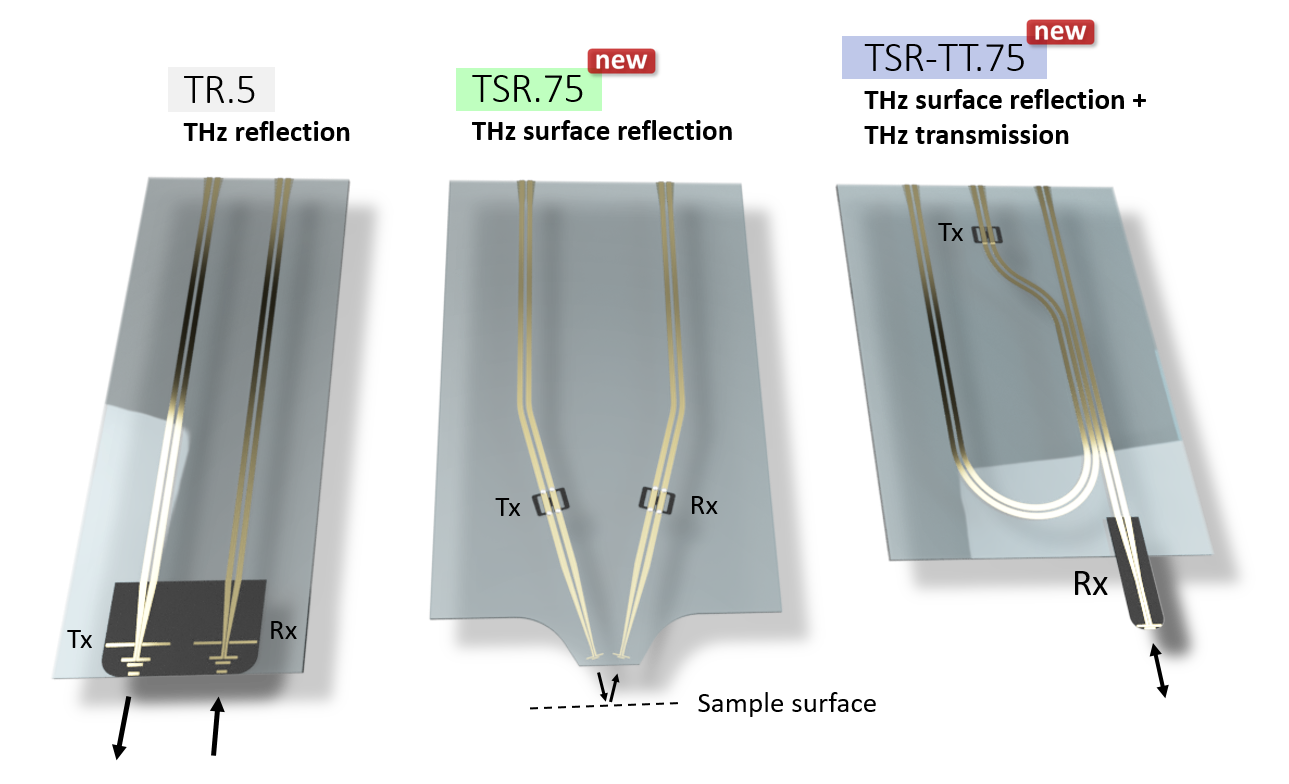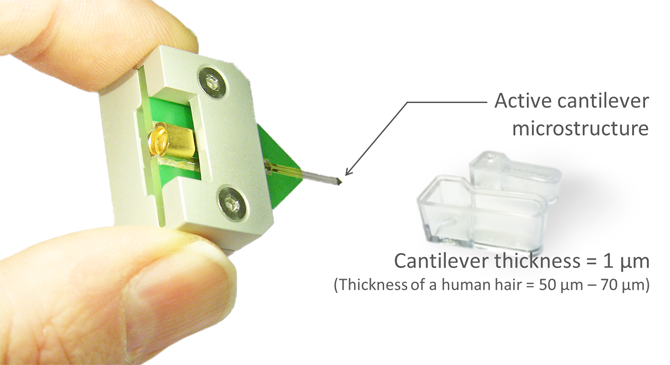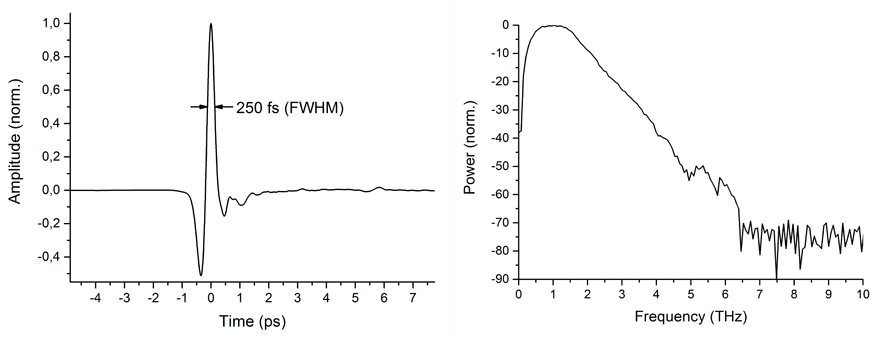Introduction
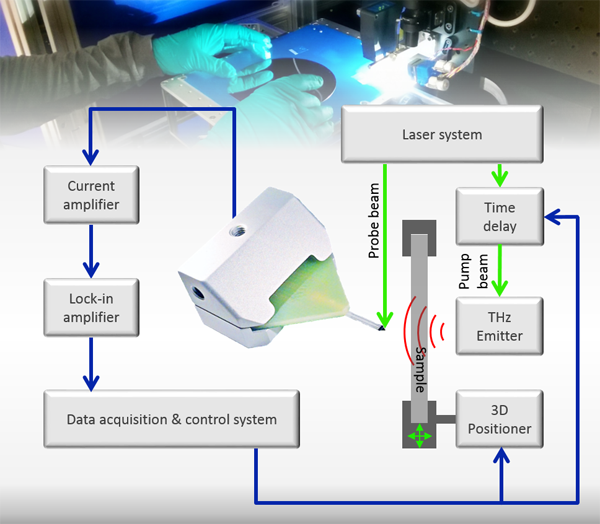
Block scheme of a typical terahertz time-domain measurement system for near-field transmission measurements.
Breaking the resolution limits of standard THz imaging systems and opening the door to direct THz-based microstructure analysis:
The patent-protected TeraSpike microprobe series offered by Protemics enables the surface-near detection of THz light with micron-resolution. This covers applications ranging from contactless sheet resistance measurement or time-domain reflectometry for fault isolation in chip-packages to THz near-field imaging at planar THz devices, metamaterials or waveguides. Thanks to the low optical power requirements of the TeraSpike microprobes (typ. <4 mW average power) they are compatible to most pulsed laser sources (pulse durations < 150 fs recommended).
We also offer design and fabrication services for custom products as well as measurement services and research studies. Please contact us for further information.
For further technical information please also refer to our product brochure.
Product Inquiries
Scanning systems
Our scanning system solutions are the ideal modular platform for THz near-field imaging applications of any kind. All system components are optimized for the utilization of TeraSpike microprobes at maxmimum performance.
Standard scanning system configurations may be combined with a suitable laser systems on customer side or can be extended with a new laser source for optical excitation.
Scanning systems are designed for applications such as:
- THz Metamaterial research and sensing application
- Semiconductor wafer inspection
- Sheet resistance imaging
- Graphene analysis
- THz device characterization
- Microstructure analysis
- Non-destructive testing
TeraCube Scientific

THz near-field scanning system
The TeraCube Scientific and the new TeraCube M2 are fully automated THz near-field scanning systems to be operated in an optical laboratory surrounding. Both systems enable time-domain measurements of THz field distributions in a controlled distance to a sample surface. Protemics proprietary TeraSpike near-field microprobes are used to image broadband THz pulses transmitted through or reflected from planar samples.
Key features:
- High-speed data acquisition for continuous move scanning through synchronized motion-control and real-time position detection
- Optical sample topography detection for adaptive THz surface scanning at constant microprobe/surface-distance on structured or bended samples
- Linear polarized and rotatable THz emitter for polarization-dependent measurements
- High performance THz emitter/detector components plus high dynamic range Lock-in detection for outstanding signal quality
- Optional integrated CCD camera module for monitoring of microprobe tip and sample position
- System control and measurement automation software with easy to operate graphic user interface readily installed on included PC unit
- Software-implemented alignment monitoring function and system health check electronics
- Software assisted microprobe-tip to sample surface approximation
- Time-domain signal preview mode for fast optical alignment alignment
- Data-export as plain-text or Matlab-compatible format
- System housing for laser and dust protection
- Open extendable lab-type system platform
Technical Specifications
| Type | TeraCube Scientific | TeraCube M2 |
| Spectral range | 0.05 - 3 THz | 0.05 - 4 THz |
| Maximum sample size (x, y, z) | 20 cm, 20 cm, 1 cm | |
| Maximum scanning speed (x, y) | up to 100 mm/s | |
| Min. scanning time per pixel | 10 ms / Single TD position | 10 ms / Full TD Transient (5ps) |
| Maximum scanning range (x, y, z) | 18 cm, 18 cm, 3 mm | |
| Time-domain scanning range width | 1000 ps | 5 .. 200 ps |
| Time-domain step resolution (dt) | 6.6 fs | 50 fs |
| Min. bi-directional repeatability (x, y, z) | +-0.1 µm, +-0.1 µm, +-0.15 µm | |
| Min. step resolution (dx, dy, dz) | 0.1 µm, 0.1 µm, 0.15 µm | |
Installation requirements
Vibration-damped optical table with 1.5 m x 1m x 1m of space for system placement
Laser laboratory specification of class 3B or higher
For further information or quote requests please contact us.
TeraSpike microprobe series
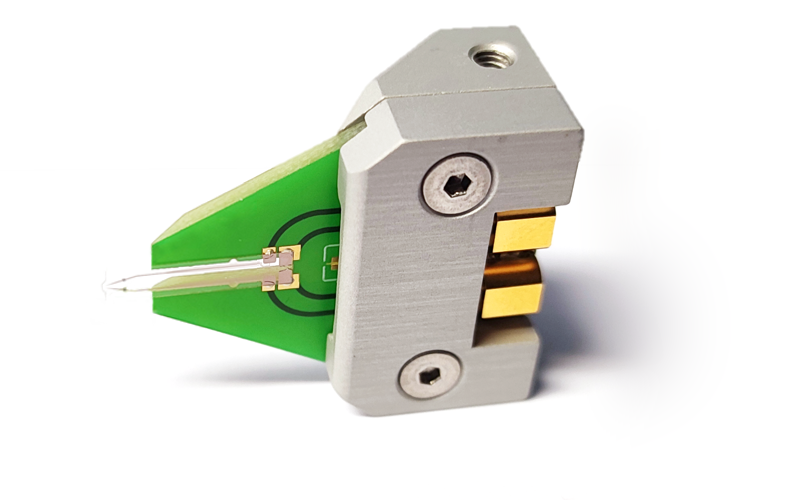
TeraSpike TD-800-TR series
Our portfolio of TeraSpike probes for reflection-mode measurements has been extended by two further models: the TSR.75 and the TSR-TT.75. The new series of Terahertz transceiver probes now serves a wider range of application scenarios, starting with volume inspection (TR.5), near-surface volume inspection with increased spatial resolution (TSR.75) and surface scanning with maximum spatial resolution (TSR-TT.75). While basically all TR series probes can be used also for transmission-mode operation, the TSR-TT.75 is best suited for this mode in respect of highest spatial resolution.
The TR series is taking advantage of Protemics´ proprietary “wave-trap” design for the suppression of probe-internal reflection signals as well as the XR-type flexible cantilever design for increased mechanical robustness. Our transceiver probes provides access to sub-wavelength-resolution and shortest THz transmissions paths.
TR series comparison chart:
| Model TD-800- ... | Operation mode | # of Antennas | Incidence angle [deg] | Bandwidth [THz] | Spatial Resolution [µm] |
| TR.5 | Reflection | 2 | 0 | 1.5 | 250 |
| TSR.75-PCS10-50 | Reflection | 2 | 15 | 3 | 100 |
| TSR-TT.75-PCS10-50 | Reflection and Transmission | 1 | 0 | 2 | 40 |
For more information please refer to our product brochure (2 MB PDF-file) and take a look into our FAQ section.
TR series probes are based on the patent applications DE 10 2009 000 823.3, DE 10 2014 015 516.1, DE 10 2016 002 733.9, DE 10 2020 002 735.0.
TeraSpike TD-800-TR.5
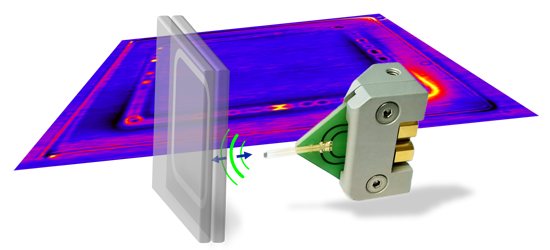
The new TeraSpike model TR.5 comes with a pair of closely spaced photoconductive THz antennas offering new means for high-performance near-field measurements in reflection-mode. While one antenna is used as a radiation pulse generator, the other antenna is used as the detector. The slim transceiver probe is taking advantage of Protemics´ proprietary “wave-trap” design for the suppression of probe-internal reflection signals as well as the XR-type flexible PET cantilever design for increased mechanical robustness. In contrast to standard reflection-mode approaches based on far-field emitter/detector components the new near-field transceiver probe provides access to sub-wavelength-resolution and shortest THz transmissions paths.
Microprobe antenna design:
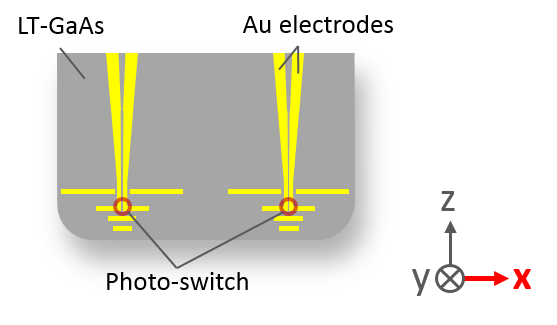
Technical specifications:
| Type | -TR.5 | |
| Dark current @ 1 V Bias | < 1.5 nA | |
| Photocurrent @ 1 V Bias | > 0.5 µA | |
| Excitation wavelength | 700 .. 860 nm | |
| Average excitation power | 0.1 .. 4 mW | |
| Connection type | 2x SMP | |
Each probe is individually tested and comes with manual and test certificate. For more information please refer to our product brochure (2 MB PDF-file) and take a look into our FAQ section.
TeraSpike TD-800-TSR.75

Microprobe cantilever design:

Technical specifications:
| Type | TSR.75-PCS10-50 |
| Max. spatial resolution | 100 µm |
| Dark current @ 1 V Bias | < 10 nA (typ. < 1.5 nA) |
| Photocurrent @ 1 V Bias | >0.1 µA (typ. >0.25 µA) |
| Excitation wavelength | 700 .. 860 nm |
| Average excitation power | 0.1 .. 3 mW |
| Connection type | 2x SMP |
TR-series microprobes are mainly sensitive to THz field components oriented in transversal direction to the probe-tip axis as defined by the x-axis direction in the upper illustration.
Each probe is individually tested and comes with a manual & test certificate. For further information please take a look at our brochure (PDF file, 2 MB) and FAQ section.
Application example (IC authenticity verification*):
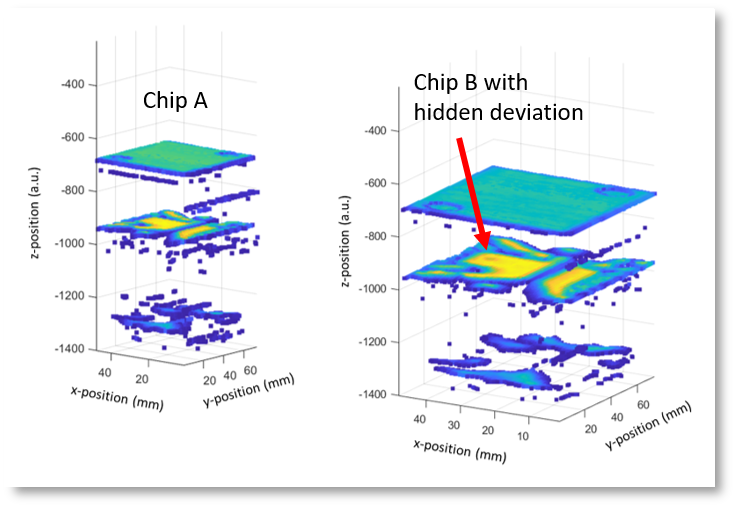
*Sample ICs courtesy of Dr. Asadi’s group, Florida Institute for Cybersecurity Research (FICS). Stacked interface and buried structure localization based on Protemics' software package Teraloc - optimized for TeraSpike-probes.
TeraSpike TD-800-TSR-TT.75
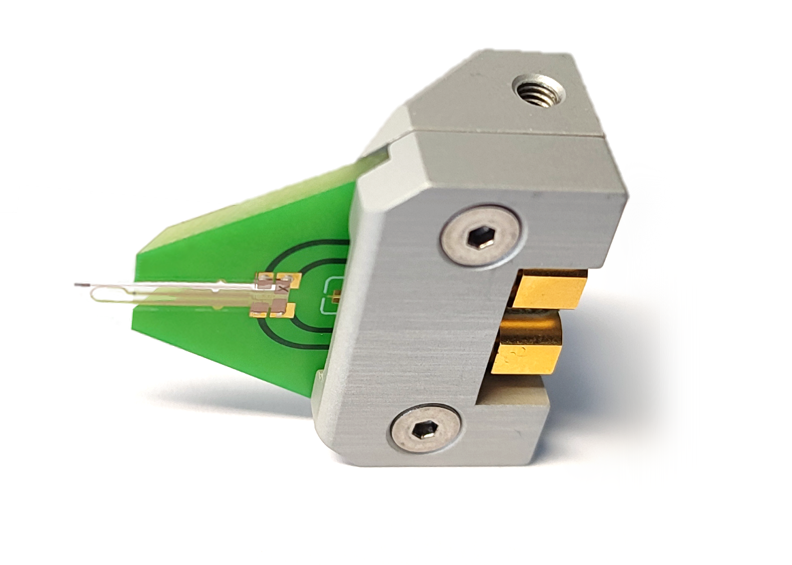
Microprobe cantilever design:

Technical specifications:
| Type | TSR-TT.75-PCA-PCS10-50 |
| Max. spatial resolution | 40 µm |
| Dark current @ 1 V Bias | < 10 nA (typ. <1.5 nA) |
| Photocurrent @ 1 V Bias | >0.1 µA (typ. >0.25 µA) |
| Excitation wavelength | 700 .. 860 nm |
| Average excitation power | 0.1 .. 3 mW |
| Connection type | 2x SMP |
TR-series microprobes are mainly sensitive to THz field components oriented in transversal direction to the probe-tip axis as defined by the x-axis direction in the upper illustration.
Each probe is individually tested and comes with a manual & test certificate. For further information please take a look at our brochure (PDF file, 2 MB) and FAQ section.
Application example (Thin-film inspection*):
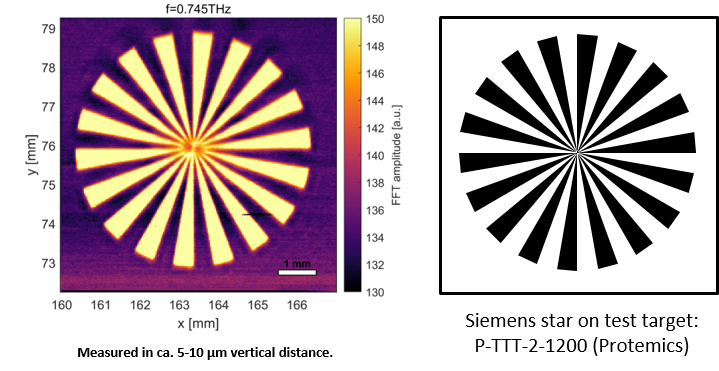
*Terahertz test target P-TTT-2-1200 with Cr layers of 10 nm and 50 nm thickness - equivalent to approx. 250 Ohm and 50 Ohm sheet resistance, respectively.
TeraSpike microprobe series
Photoconductive Near-field Microprobes (PC-NFMs) for the THz-Range
Introducing TeraSpike, the next generation of high-performance microprobes for photo-conductive THz near-field imaging. Achieve superior signal quality and minimal invasiveness in surface-near electric THz field detection. Seamless integration with 800nm/1550nm pump/probe systems offers a cost-effective path to high-resolution THz imaging.
Key features
- Smallest photo-conductive THz microprobe on the market
- Patented design
- Spatial resolution up to 3 µm
- Accessible frequency range 0 .. >4 THz
- Many application specific optimization types available
- Adaptable to all laser-based THz-Systems with λ around 800 nm or 1550 nm
- Required optical excitation power only 1-4 mW (1-5 µJ/cm²)
- Integrated overvoltage protection circuit
- System integration accessories available
Standard Detector Overview 
Our standard probes are designed for pulsed time-domain (TD) THz spectroscopy. However, frequency-domain operation has also been successfully demonstrated for specific types. Please inquire for further information. Detector probes are grouped by:
- Exitation wavelength type: 800 nm or 1550 nm
- Field polarization type: x- or z-polarisation (Transversal or longitudinal orientation)
- Optimization type:
- HR: High spatial resolution
- HRS: High spatial resolution plus resonant sensitivity enhancement
- N: Non-resonant (Z-Probe)
- A-500G: Axial-dipol, resonant at 500 GHz (Z-Probe)
- WT: High spectral purity
- HR-WT: High-resolution plus high spectral purity and bandwidth
- HR-WT-XR and WT-XR: High-bandwith and increased mechanical robustness
In addition to our standard probes listed above we can also offer custom-specific microprobes (please inquire).
Electrical connection is done through a compact coaxial SMP plug. We recommend the use of our low-noise current amplifier TS Companion.
Exemplary THz measurement data

THz pulse transient (left) measured with the TeraSpike TD-800-X-HR-WT in a TeraCube M2 system. Signal-to-noise power spectrum (right) generated by Fast-Fourier-Transformation of the time-domain data. Measurement were conducted without purging the system with Nitrogen.
TeraSpike TD-800-X
Microprobe cantilever design:

Technical specifications:
| Type | HR | HRS |
| Max. spatial resolution | 3 µm | 20 µm |
| Photo-switch gap size | 1.5 µm | 2 µm |
| Dark current @ 1 V Bias | < 0.5 nA | < 0.5 nA |
| Photocurrent @ 1 V Bias | >0.2 µA | > 0.2 μA |
| Excitation wavelength | 700 .. 860 nm | 700 .. 860 nm |
| Average excitation power | 0.1 .. 4 mW | 0.1 .. 4 mW |
| Connection type | SMP | SMP |
X-series microprobes are sensitive to THz field components oriented in transversal direction to the probe-tip axis as defined by the x-axis direction in the upper illustration. The HR-option does not include a resonant antenna element and provides a somewhat higher bandwidth. The HRS-option includes an antenna element for enhanced sensitivity around 1 THz.
Each probe is individually tested and comes with a manual & test certificate. For further information please take a look at our brochure (PDF file, 2 MB) and FAQ section.
TeraSpike TD-1550-X
Microprobe cantilever design:
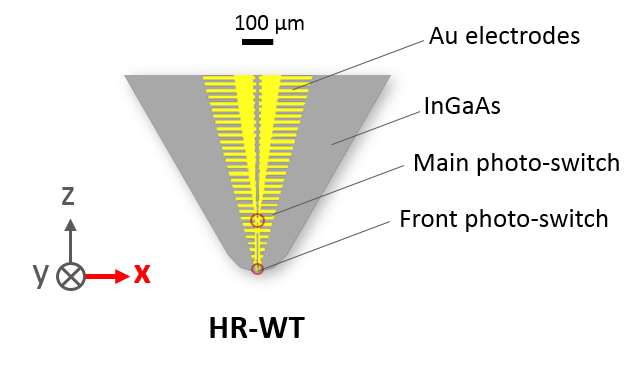
The microprobes from the new 1550-X-series are our first probes which can be directly sampled by telecom-wavelength (1500 .. 1600 nm) laser pulses. They are sensitive to electric vector field-components oriented in transversal direction to the probe-tip axis as defined by the x-axis direction in the upper illustration. The model TD-1550-X-HR-WT offers good spatial resolution and clean spectral response due to our patent-pending internal absorber ("wave-trap") structures. The model TD-1550-X-HR-WT-XR provides increased mechanical robustness with only moderate loss of spatial resolution and sensitivity. It is designed for rougher applications e.g. where the sample distance is more difficult to control.
Technical specifications:
| Type | -HR-WT | -HR-WT-XR |
| Max. spatial resolution | 40 µm (20 µm(#)) | 80 µm |
| Photo-switch gap size | 1.5 µm | 1.5 µm |
| Dark current @ 1 V Bias | < 4.5 µA | < 4.5 µA |
| Photocurrent @ 1 V Bias | > 12 µA (*) | > 12 µA (*) |
| Excitation wavelength | 1500 .. 1600 nm | |
| Average excitation power | 1.5 .. 3.5 mW | |
| Connection type | SMP | |
(*) For a focus diameter of circa 20 µm, bias voltage 1 V , average optical excitation power 3 mW.
(#) For front-switch instead of main-switch excitation. Front-switch excitation mode is showing reduced SNR.
Each probe is individually tested and comes with manual and test certificate. For more information please refer to our product brochure (2 MB PDF-file) and take a look into our FAQ section.
TeraSpike TD-800-Z
Microprobe cantilever design:
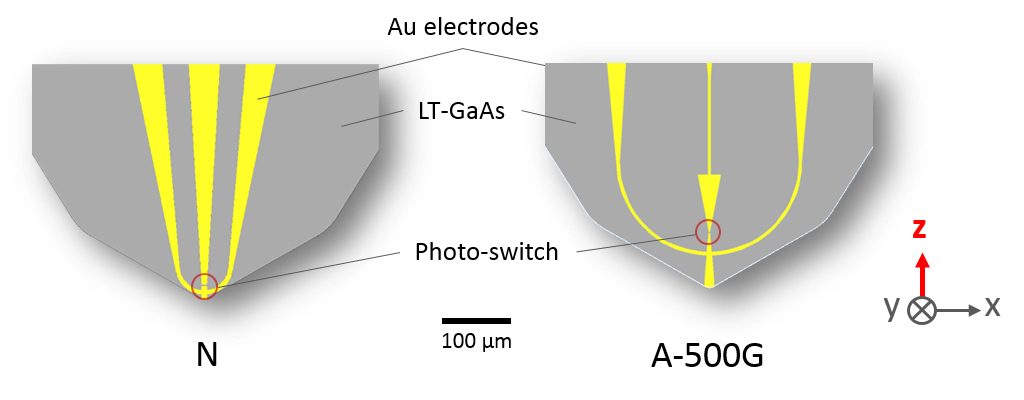
Technical specifications:
| Type | N | A-500G |
| Max. spatial resolution | 8µm | 8µm |
| Photo-switch gap size | 2µm | 5µm |
| Dark current @ 1 V Bias | < 0.4 nA | < 0.4 nA |
| Photocurrent @ 1 V Bias | >0.1 µA | > 0.2 μA |
| Excitation wavelength | 700 .. 860 nm | 700 .. 860 nm |
| Average excitation power | 0.1 .. 4 mW | 0.1 .. 4 mW |
| Connection type | SMP | SMP |
Z-series microprobes are sensitive to THz field components oriented in longitudinal direction to the probe-tip axis as defined by the z-axis direction in the upper illustration. The N-option does not include a resonant antenna element and provides a somewhat higher bandwidth. The A-500G-option includes an antenna element for enhanced sensitivity around 0.5THz.
Each probe is individually tested and comes with a manual & test certificate. For further information please take a look at our brochure (PDF file, 2 MB) and FAQ section.
TeraSpike Starter-kit
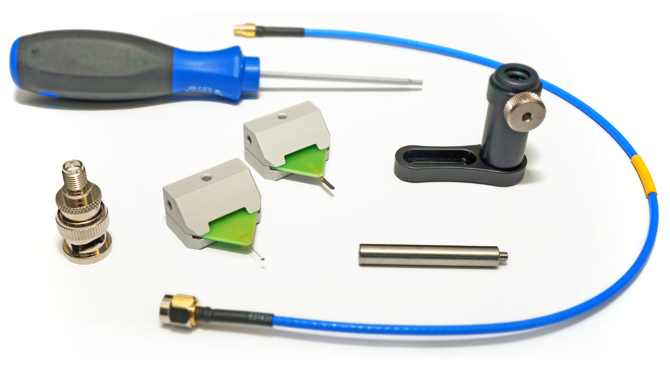
This kit is the ideal solution to start with. It includes the following components:
- TeraSpike microprobe from the X- or Z-series.
- TeraSpike phantom (dummy device)
- TS cable connection (SMP to SMA)
- SMA to BNC adapter
- Mount and post
With this set the orientation of the mounted TeraSpike microprobe can be freely chosen as required by the application. The use of the dummy device TeraSpike Phantom - as included in the starter kit - is recommended during all mechanical set-up and construction works because the risk of an uncontrolled mechanical impact during such processes can be easily avoided. Each microprobe is delivered in a robust transport and storage box.
Each probe is individually tested and comes with a manual & test certificate. For more information please refer to our product brochure (2 MB PDF-file) and take a look into our FAQ section.
TeraSpike XR-option
The standard design of the TeraSpike probe is optimized for highest spatial resolution, lowest field invasiveness and highest sensitivity. This is achieved through the free-standing semiconductor-based cantilever microstructure containing the active field sensor elements. The mechanical robustness of this standard design matches the requirements of long-term application in well controlled and automated systems such as the TeraCube Scientific allowing also pointed sample contact.
For application in rougher environments or where the sample distance is more difficult to control the new XR-design is an excellent choice with drastically further increased mechanical robustness combined with only low reduction of spatial resolution and sensitivity.
Comparison of cross-section designs - Standard vs. XR-option:
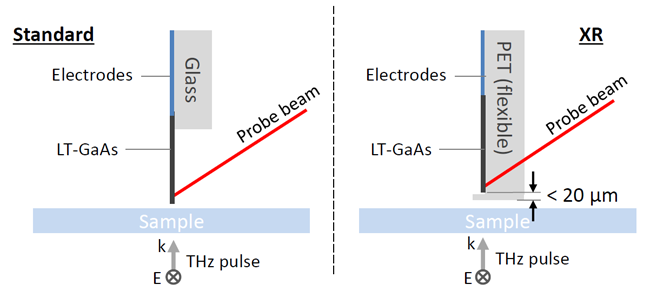
Time- and frequency-domain response - Standard vs. XR-option:
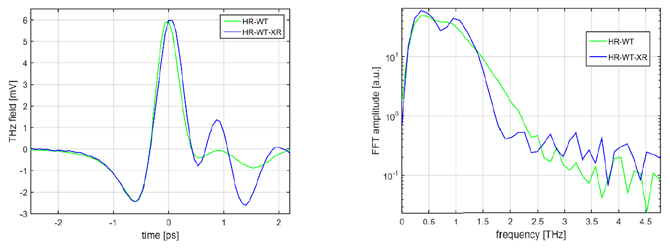
The XR-option is currently available for the following x- and z-field sensitive TeraSpike probes:
- TeraSpike TD-800-X-HR-WT-XR
- TeraSpike TD-800-Z-WT-XR
If you are interested in an XR-option for other TeraSpike models, please contact us.
TeraSpike WT-option
TeraSpike near-field probes are used under different excitation conditions. Some configurations might generate THz modes which are able to propagate along the internal electrodes of the probe-tip. So far, these modes were observed in terms of reflection signals in the recorded time-domain transients.
Protemics has developed a new patent pending design* called “wavetrap” which is effectively slowing down and absorbing such probe-internal THz signal transmission.
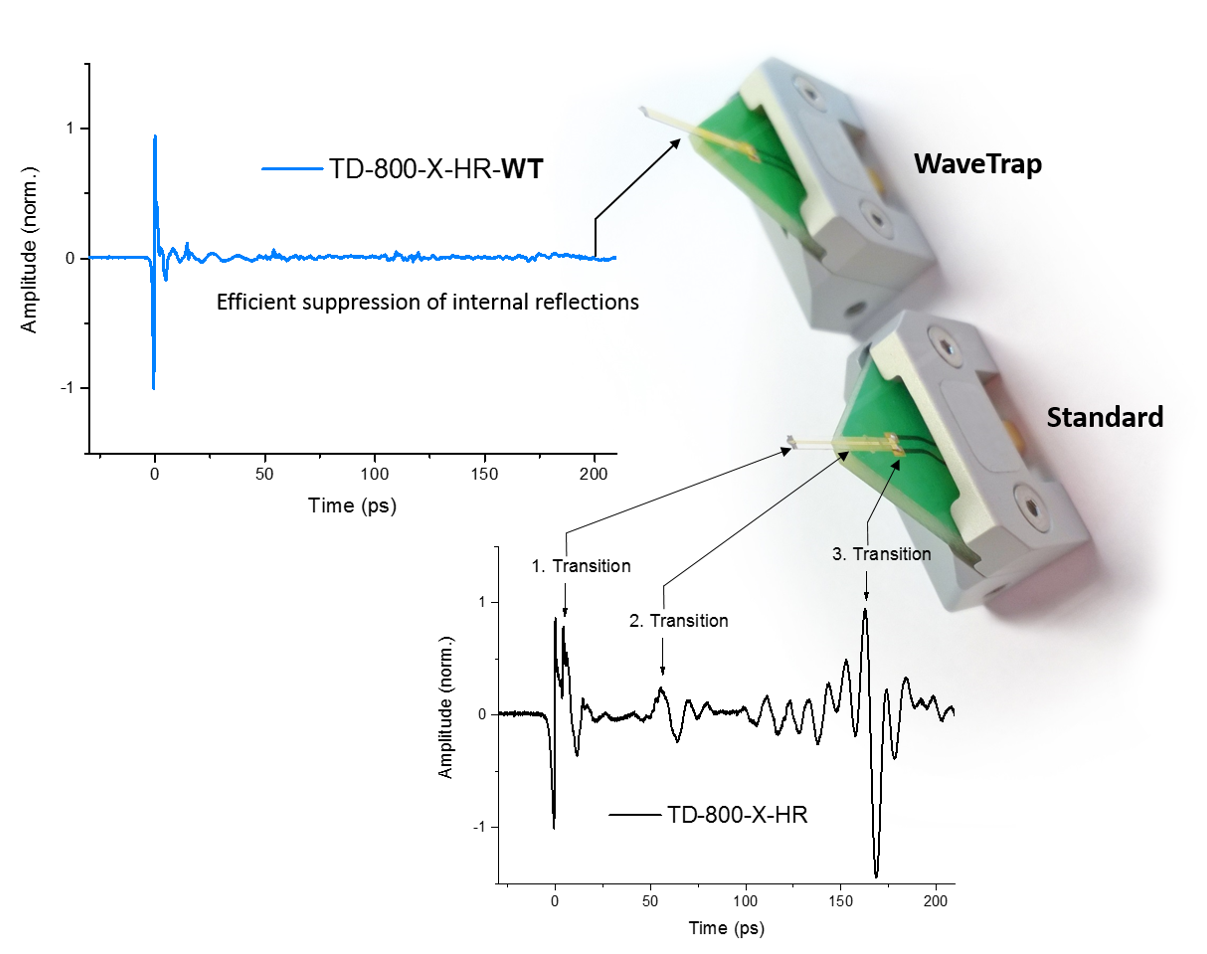
Tip designs
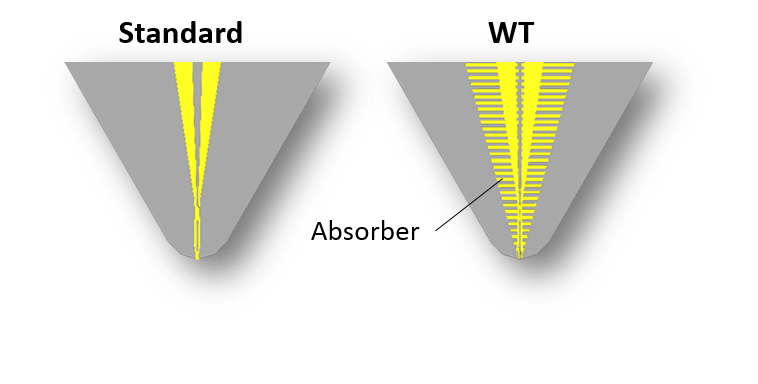
The WT-option is currently available for the following x- and z-field sensitive TeraSpike probes:
- TeraSpike TD-800-X-HR-WT
- TeraSpike TD-800-Z-WT
- TeraSpike TD-800-X-HR-WT-XR
- TeraSpike TD-800-Z-WT-XR
If you are interested in an WT-option for other TeraSpike models, please contact us.
*German patent application DE 10 2014 015 516.1
TeraSpike TD-1550-Y-BF
Microprobe cantilever design:
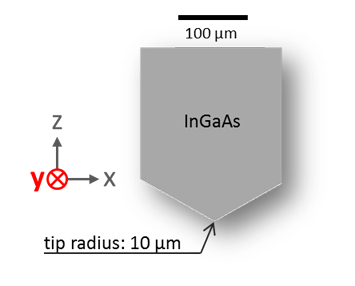
The TeraSpike TD-1550-Y-BF is a microprobe emitter based on patent pending design (DE 10 2013 020 216.7) for the bias-free surface-near excitation of Terahertz pulses on planar waveguides, metallic surfaces or meta-materials. The optically generated THz field is polarized in y-direction.
Application example:
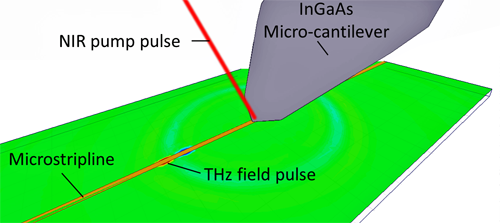
Configuration: THz pulse generation on a thin-film microstrip line using the bias-free TeraSpike emitter microprobe. For on-chip contact-free THz field detection a second TeraSpike probe from the TD-800-X or Z series can be applied.
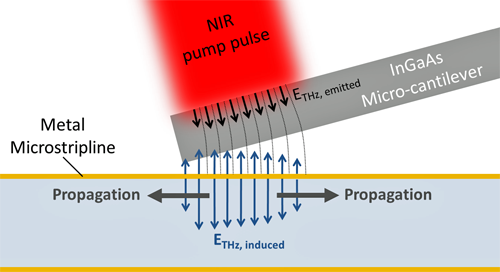
THz Emission scheme: THz pulse generation is based on optical excitation of the InGaAs micro-cantilever surface. Placing the excited tip close to a conductive structure or surface allows efficient capacitive coupling and pulse transmission.
Technical specifications:
| Type | TD-1550-Y-BF |
| Excitation wavelength | 700 .. 1600 nm |
| Average excitation power | 0.1 .. 4 mW |
| Emission bandwidth (for 90 fs pulse excitation) | > 2.5 THz |
Each probe is individually tested and comes with manual and test certificate. For more information please refer to our product brochure (2 MB PDF-file) and take a look into our FAQ section.
TeraLineX_ultra TD-800-CPS
CPS-based on-chip THz TDS platform
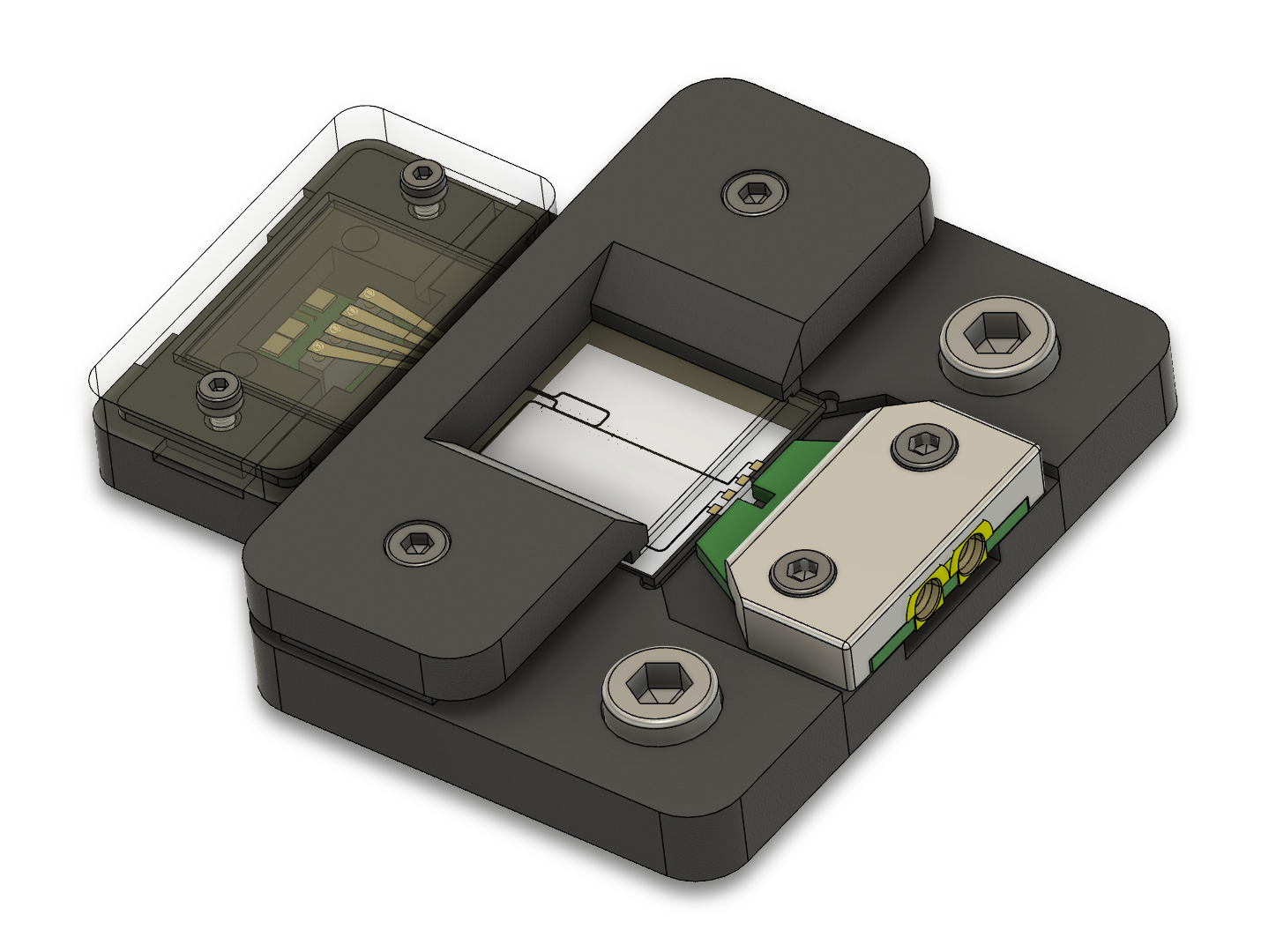
Key facts:
- TeraLineX_ultra: A versatile on-chip THz time-domain spectroscopy (TDS) platform based on a low-loss Co-planar stripline (CPS) design.
- Enables THz Spectroscopy: Operates at micron-scale, allowing analysis of devices and samples smaller than the THz diffraction limit.
- Enhanced Interaction: Facilitates interaction with thin-film samples due to planar THz mode propagation.
- Flexible Operation: Can be used in small cryo-chambers at low temperatures and in magnetic fields.
- Cost-Efficient: Supports interchangeable daughter-boards as sample carriers.
- Customizable Configuration: The TLX_ultra can be individually configured for various key parameters (refer to the table below). Additional configurations available upon request.
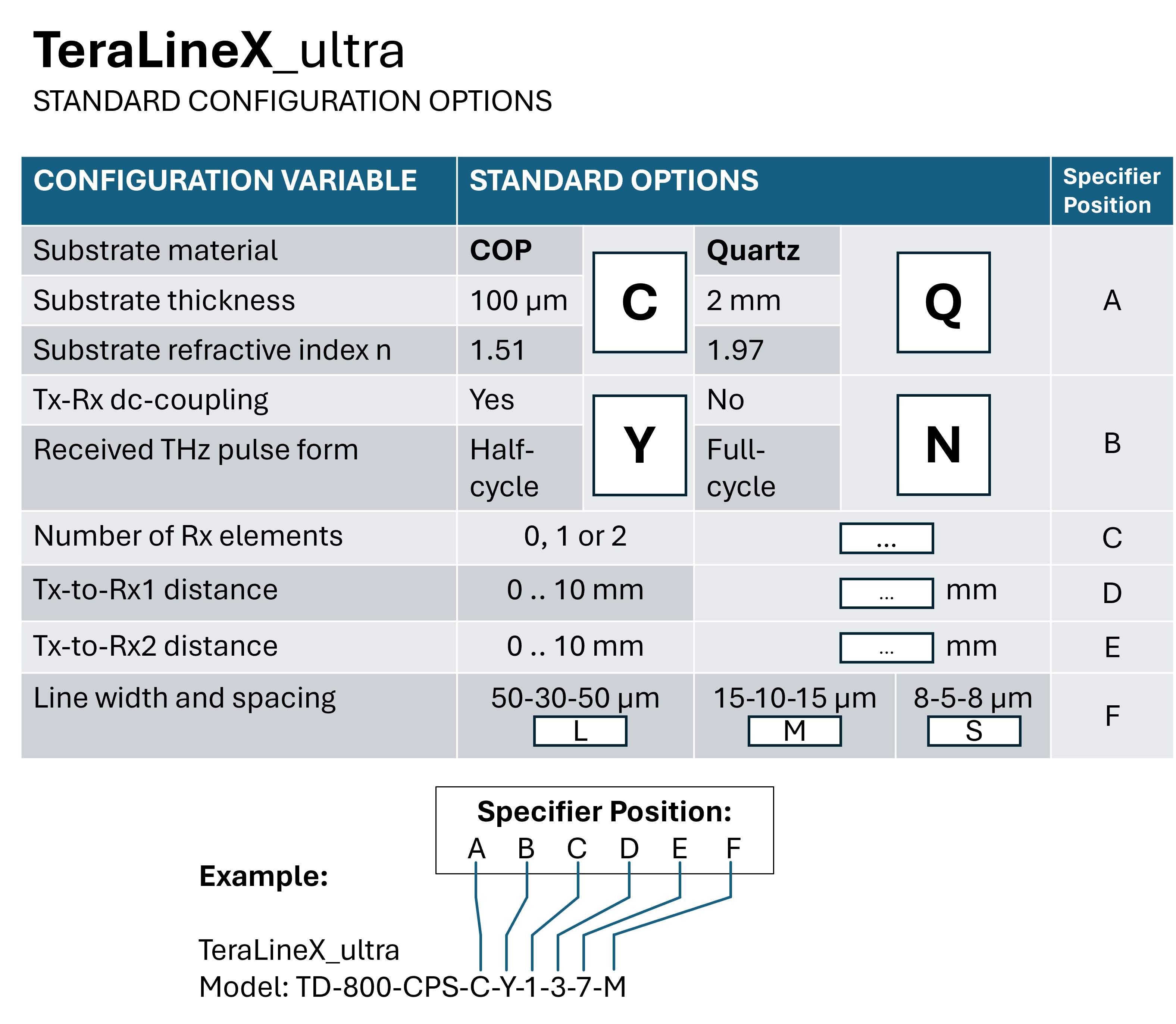
Exemplary configuration schemes:
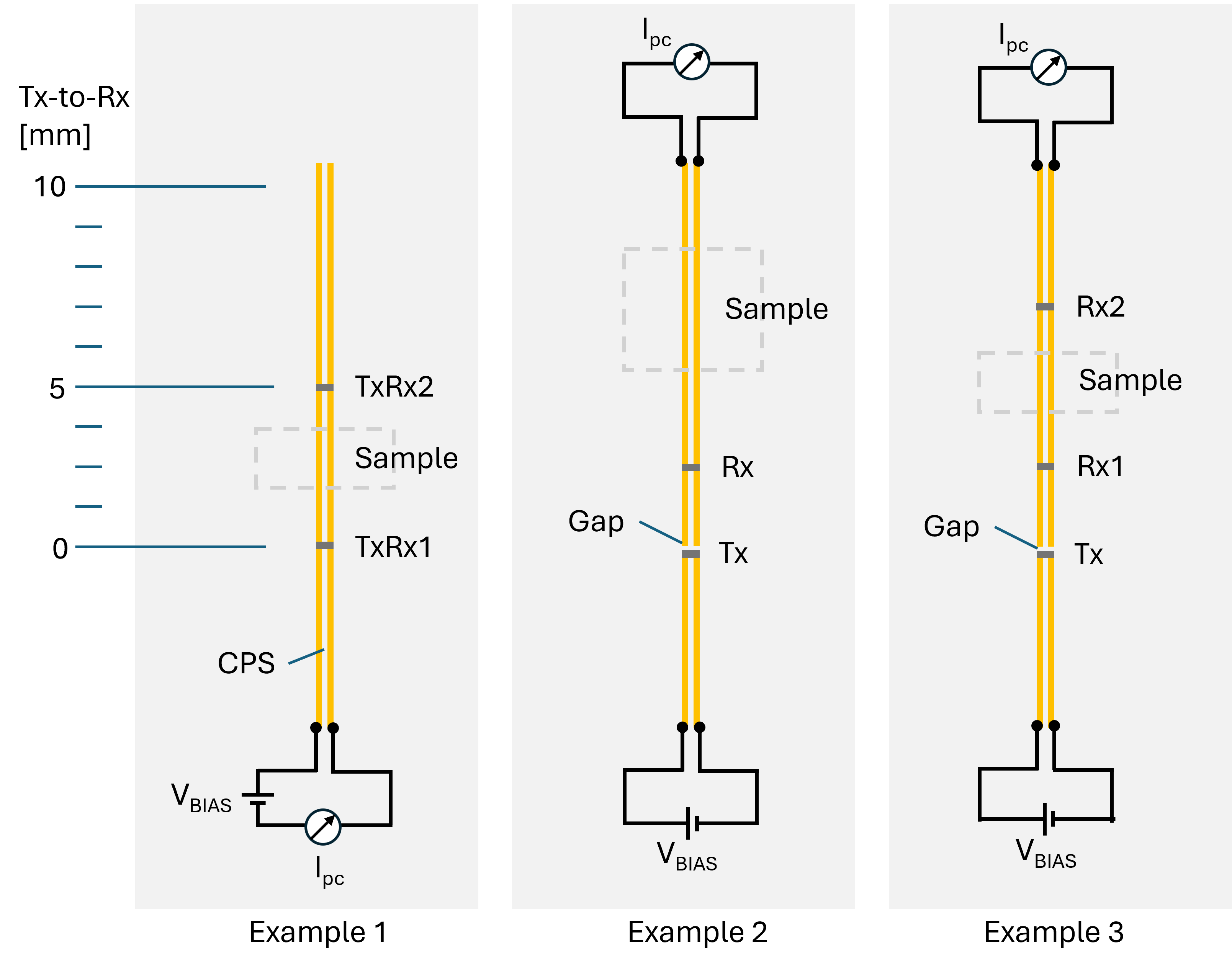
Measurement performance:

Technical specifications:
| TeraLineX-ultra TD-800-CPS- | Emitter (Tx) | Detector (Rx) |
| PC gap size | 30 µm, 10 µm or 5 µm | 30 µm, 10 µm or 5 µm |
| Dark current @ 1 V Bias | < 0.5 nA | < 0.5 nA |
| Photocurrent | > 0.1 µA(a) | > 0.1 µA(b) |
| Excitation wavelength | 700 .. 860 nm | |
| Avg. excitation power | 0.1 .. 4 mW | 0.1 .. 4 mW |
| Connection type | SMP | |
(a) For a focus diameter of circa 30 µm, bias voltage 9 V , average optical excitation power 4 mW and 10 µm PC gap.
(b) For a focus diameter of circa 30 µm, bias voltage 1 V , average optical excitation power 4 mW and 10 µm PC gap.
For more information please check the product brochure or contact us.
TeraLineX TD-800-CPS
CPS-based on-chip THz TDS device series
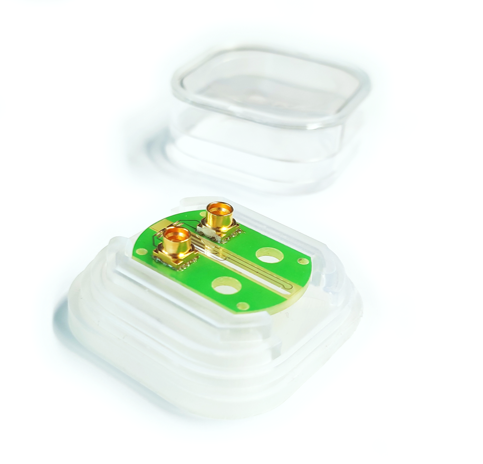
Key facts:
- The TeraLineX is a versatile on-chip THz time-domain spectrocopy (TDS) platform based on a low-loss Co-planar stripline (CPS) design.
- Enables THz time-domain spectroscopy at micron-scale devices/samples much smaller than the THz diffraction limit.
- Stong interaction to thin-film samples due to planar THz mode propagation.
- Can be operated in small cryo-chambers at low temperatures and in magnetic fields.
- Supports exchangable daugther-boards as sample carriers for cost-efficient operation.
- Customizable on request.
Device scheme:
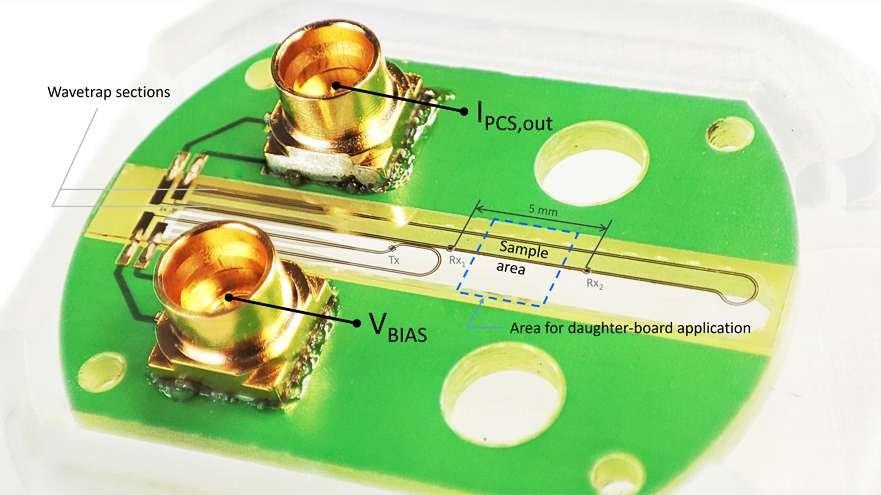
The TeraLineX includes three waveguide-embedded photo-switches: one for THz pulse generation and two for the detection of the incident and reflected signals before the sample as well as the signal transmitted behind the sample. Daughterboard samples can be flip-chip mounted to the TeraLineX motherboard.
Measurement performance:
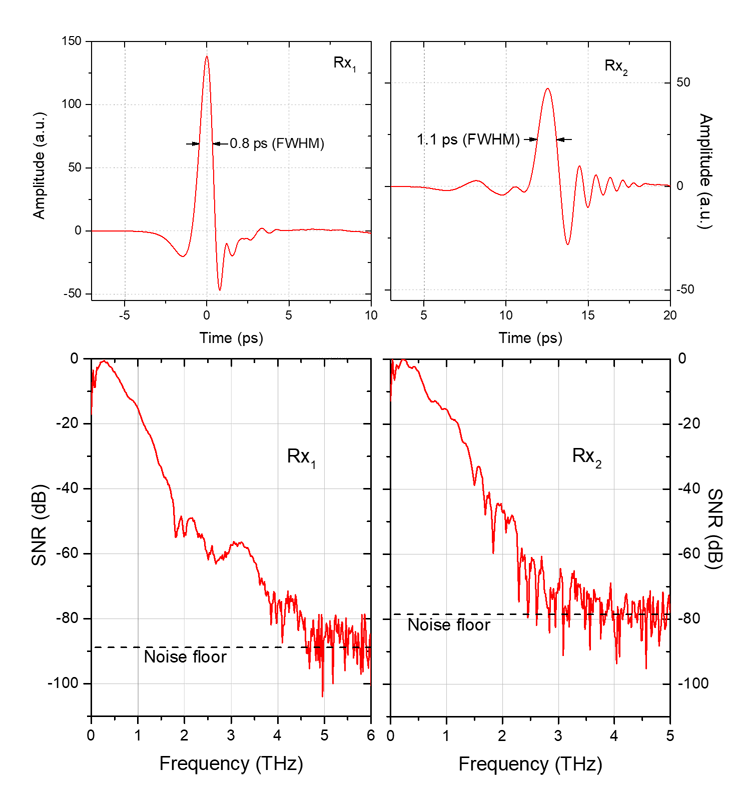
Technical specifications:
| TeraLine TD-800-CPS-CLSD-5MM | Emitter | Detector |
| PC gap size | 10 µm | 10 µm |
| Dark current @ 1 V Bias | < 0.5 nA | < 0.5 nA |
| Photocurrent | > 0.1 µA(a) | > 0.1 µA(b) |
| Excitation wavelength | 700 .. 860 nm | |
| Avg. excitation power | 0.1 .. 4 mW | 0.1 .. 4 mW |
| Connection type | SMP | |
(a) For a focus diameter of circa 30 µm, bias voltage 9 V , average optical excitation power 4 mW.
(b) For a focus diameter of circa 30 µm, bias voltage 1 V , average optical excitation power 4 mW.
For more information please check the product brochure or contact us.
GigaSpike E-field-probe series
Schottky-diode-based active 3D near-field detection
The GigaSpike field probe series features low-invasive micro-antenna structures with integrated Zero-Bias Schottky-diodes for the active measurement of 3D field amplitude distributions. GigaSpike probes are offered for the frequency range from 25 GHz to 330 GHz. Thanks to their low-invasiveness they allow field measurements in close proximity to a device under test with only a minimal amount of back-scattering of the probed field and parasitic coupling effects. The GigaSpike probe is hence an ideal device for 3D vector field amplitude or power density measurements in the far- and near-field regions of millimeter-wave emitters, such as 5G Wigig antenna arrays. They can also be used to measure the radiation profile of photo-conductive Terahertz emitters.
|
Standard models |
Frequency range |
|
| GS-28-XYZ | 25 .. 32 GHz | |
| GS-60-XYZ | 56 .. 70 GHz | |
| GS-285-X | 250 .. 330 GHz | |
Customized probes for other frequency ranges are available on request.
GigaSpike GS-60-XYZ
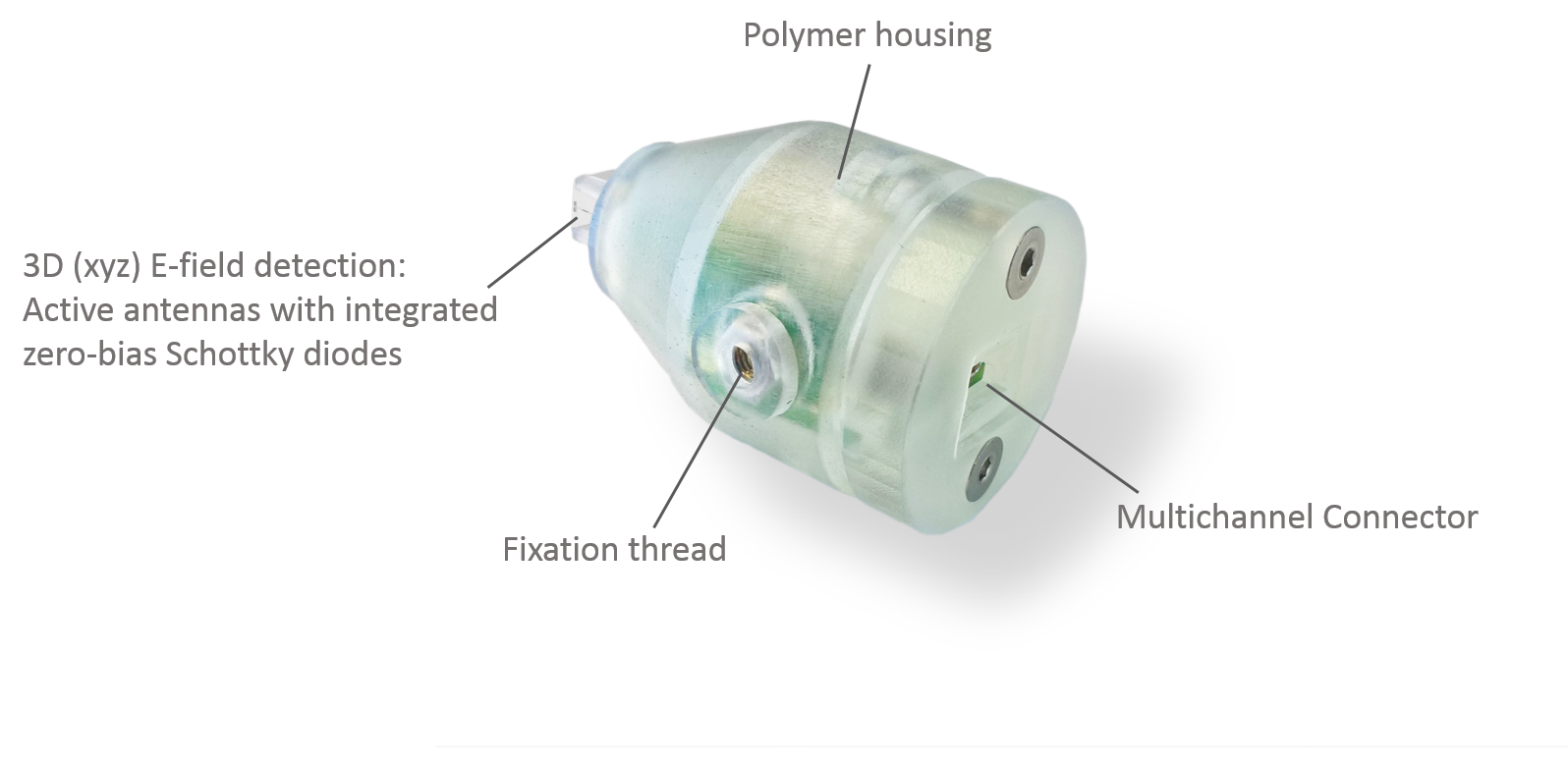
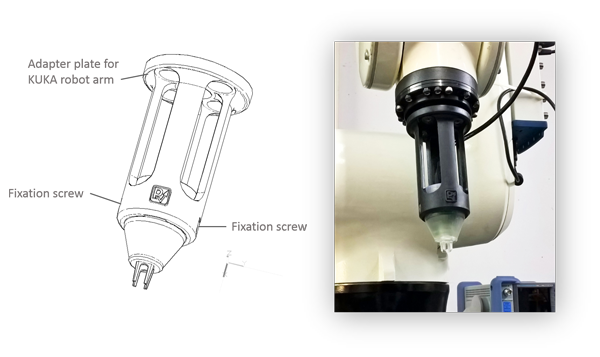

Probe response curve: DC output voltage versus high-frequency E-field amplitude strength.
Technical specifications:
|
GigaSpike GS-60-XYZ |
Min .. Max |
|
| Frequency range | 56 .. 70 GHz | |
| Power density range | 0.005 .. 200 µW/mm2 | |
| DC output voltage range | 0.1 mV .. 1100 mV | |
| Responsivity | 5500 .. 20000 Vmm2/W | |
GigaSpike technical information download.
Interested in the GigaSpike high-frequency E-field probe? Please inquire here.
TeraBlast - Bias-free Large-area Emitters
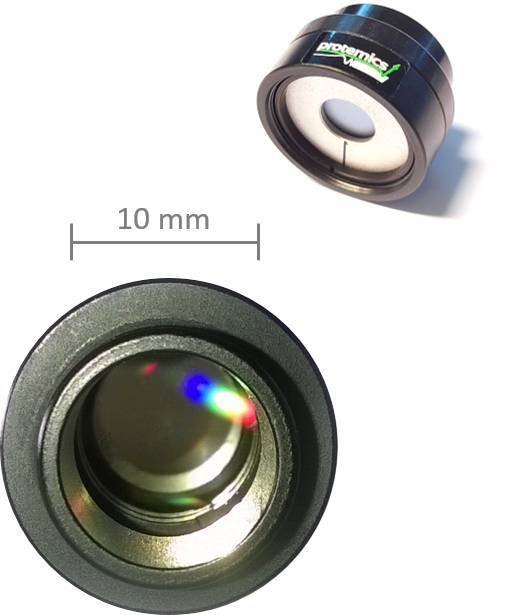
The new bias-free Terahertz emitter series TeraBlast from Protemics are optically pumped THz sources which can be used with a wide range of femtosecond laser sources (such as low power oscillators or amplified lasers with wavelengths in the range of 700..1600 nm). They are ideally suited and tested for near-field imaging applications including TeraSpike microprobe operation. The TeraBlast is however also a great emitter for far-field spectroscopy and other THz applications.
TeraBlast emitters are based on a patent pending technology (German patent application: DE102012010926 A1) utilizing bi-metallic grating structures for the optical bias-free generation of Terahertz radiation. The emitters offer a large active area and can be excited by pulsed Femtosecond lasers within a broad range of average power from 5 mW up to above 1 W without causing the typical signs of conversion efficiency saturation or device failures as known from small-scale photoconductive antennas. Furthermore, TeraBlast emitters are the ideal solution for applications where THz pulse generation needs to occur in close proximity to photoconductive detection (e.g. near-field detection or butt-coupled waveguide excitation). In such situations voltage-biased emitters are often unusable because of strong parasitic coupling effects from modulated photocurrents which are avoided for the bias-free TeraBlast emitters.
Key benefits:
- High conversion efficiency due to advanced nano-scale bi-metal structure design
- High emission power from saturation-free large active area
- Recommended THz source for TeraSpike microprobe operation
- Unmatched simple handling
- Virtually no alignment/focusing effort
- Can be used as a point source or array emitter
- Linearly polarized emission
- Extremely robust due to bias-free operation
- No device failure on local short-cut defects
- No dark current
- No parasitic off-set signal generation in lock-in detection schemes
Radiation characteristic and working principle:
THz pulse emission is generated by optical excitation of the TeraBlast emitter through femtosecond near-infrared or infrared pulses. Pulse durations < 150 fs are recommended. The emitted Terahertz radiation is linearly polarized. The following plot is showing an exemplary measurment of the emitted THz field which is line scanned across the center of the TeraBlast emitter in time-domain using a TeraSpike microprobe (Model: TD-800-X-HRS). The bright fast oscillating THz frequency components are well confined to an aperture area of few millimeter size, whereas GHz radiation is emitted over a much wider range. The emission profile can be easily adapted by adjusting the focussing of the optical excitation beam.
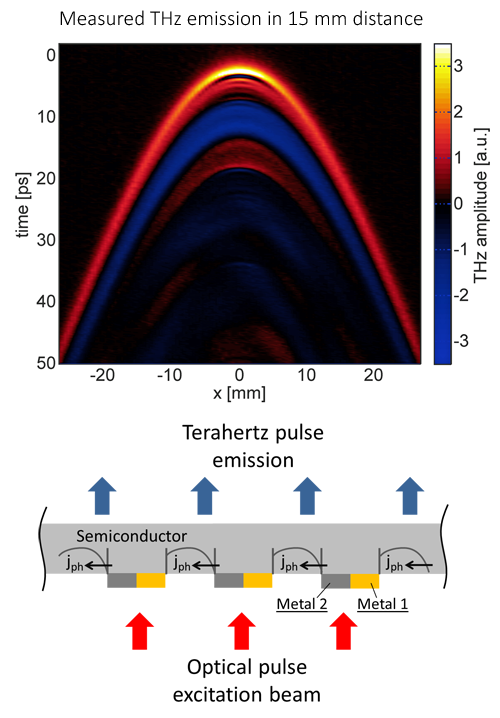
Exitation scheme: The THz emission process is based on Schottky-field induced lateral photo-currents (jph) at the multiple asymmetric metal/semiconductor junctions.
Measurement example (TeraBlast TD-1550-L-165): Far-field transmission through N2-purged free-space measured with a femto-second laser from Laser Quantum („taccor") and electrooptic detection in a 400-µm-thick GaP crystal using ASOPS based time-domain spectroscopy.
Dimensions:
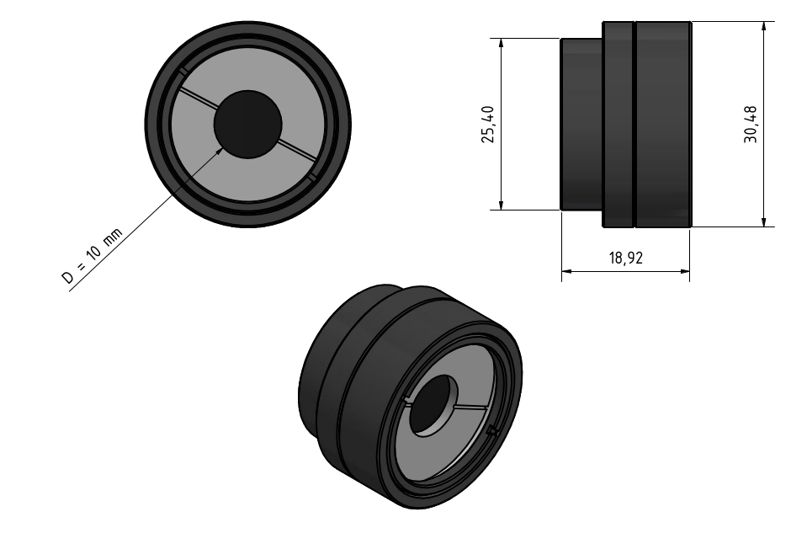
Technical specifications:
| Type | TeraBlast TD-1550-L-165 | ||
| Excitation wavelength range | 700 .. 1600 nm | ||
| Typ. average excitation power range | 5 mW .. 1000 mW | ||
| Average THz emission power | > 2.5 µW (a) | ||
| Active area diameter | ca. 10 mm (b) | ||
| Adapter dimension (Outer diameter) | 1/2 inch | ||
If you are interested in this option please contact us for further information. Please also refer to our product brochure (2 MB PDF-file) for technical details.
(a) Measured with pyroelectric detector (Spectrum Detector Inc. SPI-D-62-THz) for 370 mW optical pump power
(b) Larger active areas possible. Please request!
Low noise current amplifier
Protemics is the first company offering low noise current amplifier solutions especially optimized for THz time-domain spectrocopy applications. Our amplifiers are featuring specific interfaces and functions usually not found in general purpose amplifiers but needed in most THz TDS measurement set-ups. Further customizations are possible on request.
TeraSpike Companion

The new TeraSpike Companion is the first low-noise amplifier specially designed and optimized for THz time-domain spectroscopy applications based on photoconductive detectors and emitters - including of course also the full line of Protemics TeraSpike (TS) microprobes. In contrast to conventional current amplifiers, the TS Companion offers important additional functions that are typically required for THz-TDS-related tasks, including e.g. connections for Tx and Rx devices, an optical alignment mode, a switchable bias function for all inputs as well as a fully electronic control for system integration. A fine selection of amplification in steps of a fifth of a decade is included for optimal utilization of the maximum possible signal-to-noise ratio in any THz system. As required for operation with fast-scanning THz TDS modules (e.g. TeraFlash Pro, Toptica), it also offers a comfortable bandwidth reserve that ensures unadulterated THz signal detection up to the highest amplification range.
Key features:
- Two input channels
- Optical alignment & THz detection mode
- Gain variable in 0.2x10x steps
- 40 kHz bandwidth at every gain value
- Local and remote control options
- Optical breadboard mounts (metric)
- New: USB-interface plus stand-alone remote control software
Applications e.g.:
- Protemics near-field probe operation including transceiver, emitter or detector probes
- General THz photo-conductive antenna operation
| Model | LNA-40k-8E8 |
| Trans-impedance gain [V/A]* | 1 x 106… 8 x 108 , switchable in steps of 0.2 x 10x |
| 3-dB-Bandwidth [kHz]* | 40, for all gain settings. Switchable to 0.4 |
| Amplifier output voltage [V] | ±12 |
| Output impedance | Open |
| Max. output current [mA] | ±40 |
| External bias supply for THz device inputs | ±12 V, max. 120 mA |
| Indicator LED | On: Overload, Off: Normal operation |
| Power supply voltage | ±5 V… ±14 V (max.), ±12 V (typ.) |
| Power supply current | Typ. ±30 mA |
| Operating temperature range | 0 .. 70°C |
| Cabinet size [mm] | 80 x 71 x 24 |
| Weight [g] | 120 |
*Customizable on request
Gain spectrum:
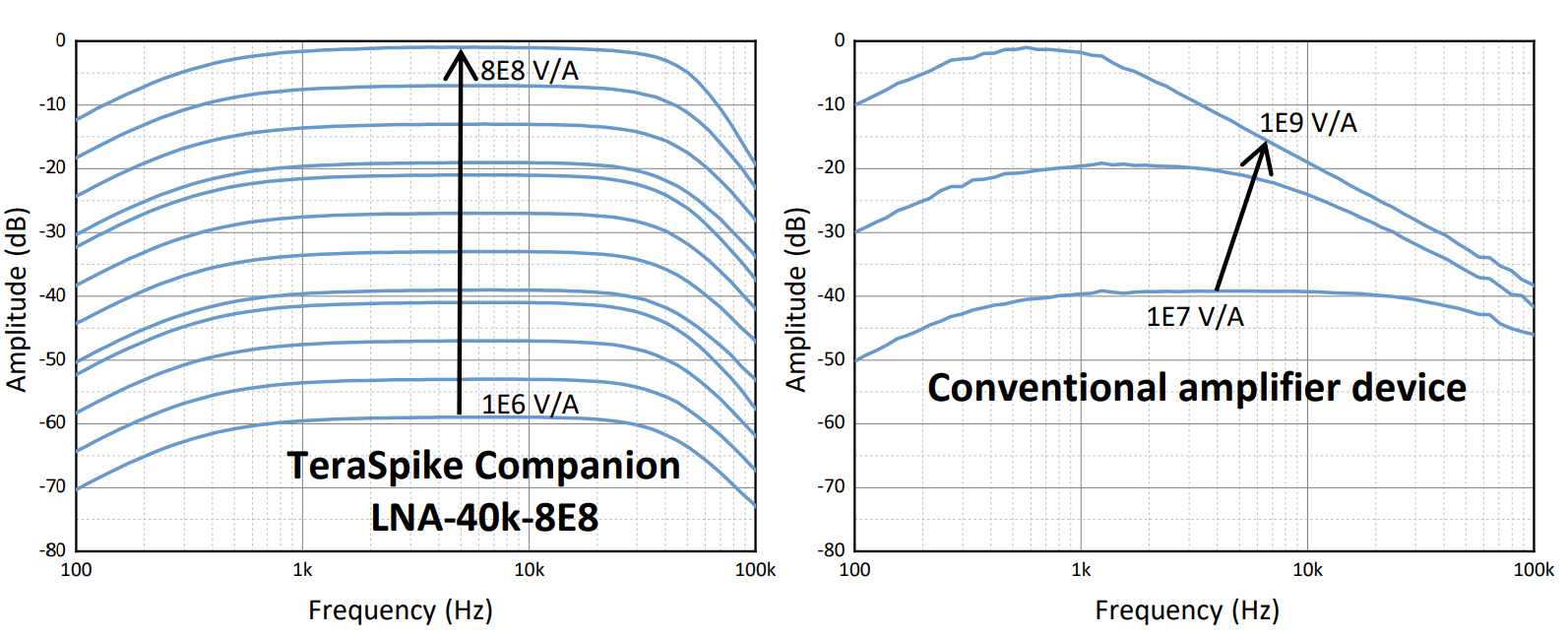
For further information please see our product brochure or contact us.
Accessory:
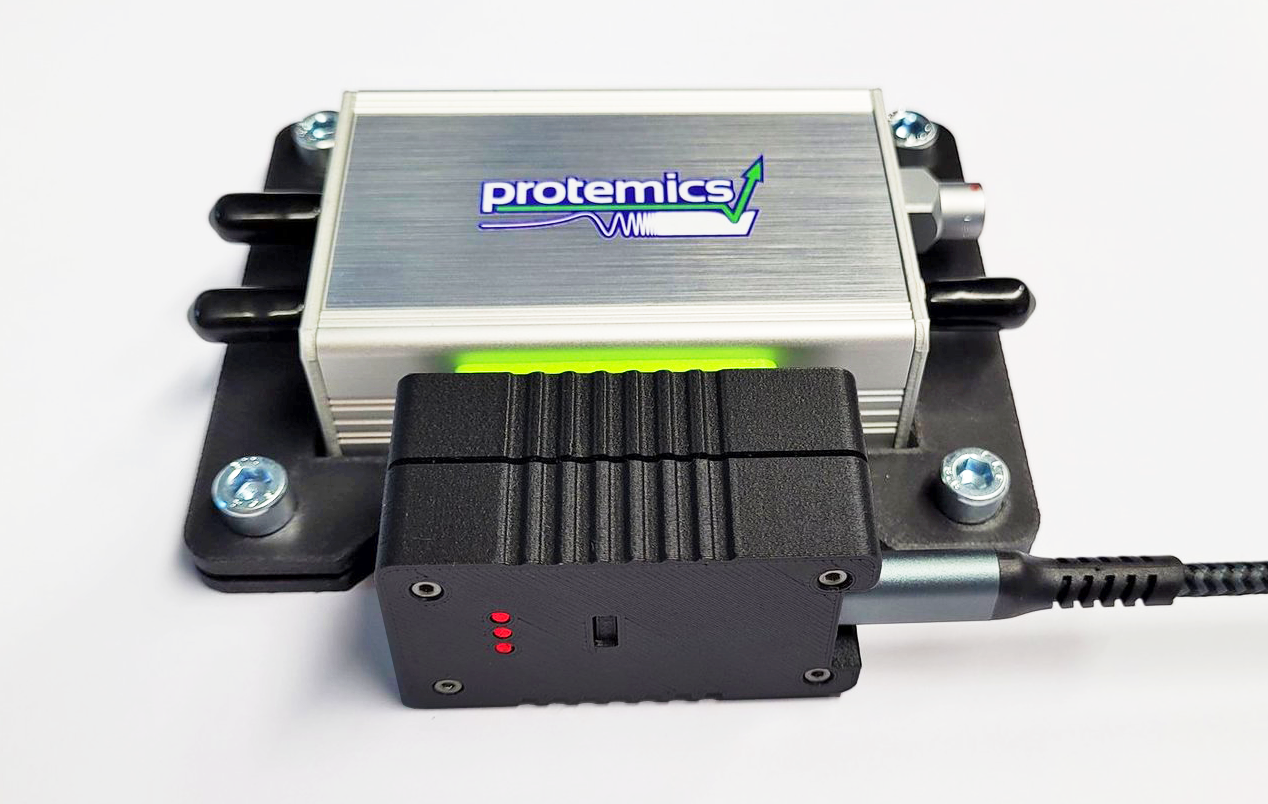
Remote Control USB-Plug (RCU)
